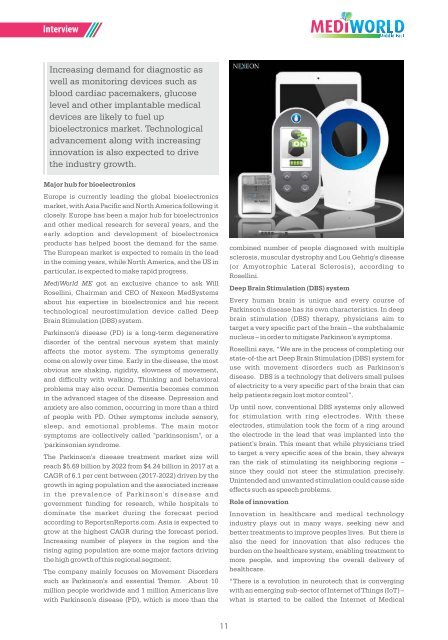You also want an ePaper? Increase the reach of your titles
YUMPU automatically turns print PDFs into web optimized ePapers that Google loves.
Interview<br />
Increasing demand for diagnostic as<br />
well as monitoring devices such as<br />
blood cardiac pacemakers, glucose<br />
level and other implantable medical<br />
devices are likely to fuel up<br />
bioelectronics market. Technological<br />
advancement along with increasing<br />
innovation is also expected to drive<br />
the industry growth.<br />
Major hub for bioelectronics<br />
Europe is currently leading the global bioelectronics<br />
market, with Asia Pacific and North America following it<br />
closely. Europe has been a major hub for bioelectronics<br />
and other medical research for several years, and the<br />
early adoption and development of bioelectronics<br />
products has helped boost the demand for the same.<br />
The European market is expected to remain in the lead<br />
in the coming years, while North America, and the US in<br />
particular, is expected to make rapid progress.<br />
MediWorld ME got an exclusive chance to ask Will<br />
Rosellini, Chairman and CEO of Nexeon MedSystems<br />
about his expertise in bioelectronics and his recent<br />
technological neurostimulation device called Deep<br />
Brain Stimulation (DBS) system.<br />
Parkinson's disease (PD) is a long-term degenerative<br />
disorder of the central nervous system that mainly<br />
affects the motor system. The symptoms generally<br />
come on slowly over time. Early in the disease, the most<br />
obvious are shaking, rigidity, slowness of movement,<br />
and difficulty with walking. Thinking and behavioral<br />
problems may also occur. Dementia becomes common<br />
in the advanced stages of the disease. Depression and<br />
anxiety are also common, occurring in more than a third<br />
of people with PD. Other symptoms include sensory,<br />
sleep, and emotional problems. The main motor<br />
symptoms are collectively called "parkinsonism", or a<br />
'parkinsonian syndrome.<br />
The Parkinson's disease treatment market size will<br />
reach $5.69 billion by 2022 from $4.24 billion in 2017 at a<br />
CAGR of 6.1 per cent between (2017-2022) driven by the<br />
growth in aging population and the associated increase<br />
in the prevalence of Parkinson's disease and<br />
government funding for research, while hospitals to<br />
dominate the market during the forecast period<br />
according to ReportsnReports.com. Asia is expected to<br />
grow at the highest CAGR during the forecast period.<br />
Increasing number of players in the region and the<br />
rising aging population are some major factors driving<br />
the high growth of this regional segment.<br />
The company mainly focuses on Movement Disorders<br />
such as Parkinson's and essential Tremor. About 10<br />
million people worldwide and 1 million Americans live<br />
with Parkinson's disease (PD), which is more than the<br />
combined number of people diagnosed with multiple<br />
sclerosis, muscular dystrophy and Lou Gehrig's disease<br />
(or Amyotrophic Lateral Sclerosis), according to<br />
Rosellini.<br />
Deep Brain Stimulation (DBS) system<br />
Every human brain is unique and every course of<br />
Parkinson's disease has its own characteristics. In deep<br />
brain stimulation (DBS) therapy, physicians aim to<br />
target a very specific part of the brain – the subthalamic<br />
nucleus – in order to mitigate Parkinson's symptoms.<br />
Rosellini says, “We are in the process of completing our<br />
state-of-the art Deep Brain Stimulation (DBS) system for<br />
use with movement disorders such as Parkinson's<br />
disease. DBS is a technology that delivers small pulses<br />
of electricity to a very specific part of the brain that can<br />
help patients regain lost motor control”.<br />
Up until now, conventional DBS systems only allowed<br />
for stimulation with ring electrodes. With these<br />
electrodes, stimulation took the form of a ring around<br />
the electrode in the lead that was implanted into the<br />
patient's brain. This meant that while physicians tried<br />
to target a very specific area of the brain, they always<br />
ran the risk of stimulating its neighboring regions –<br />
since they could not steer the stimulation precisely.<br />
Unintended and unwanted stimulation could cause side<br />
effects such as speech problems.<br />
Role of innovation<br />
Innovation in healthcare and medical technology<br />
industry plays out in many ways, seeking new and<br />
better treatments to improve peoples lives. But there is<br />
also the need for innovation that also reduces the<br />
burden on the healthcare system, enabling treatment to<br />
more people, and improving the overall delivery of<br />
healthcare.<br />
“There is a revolution in neurotech that is converging<br />
with an emerging sub-sector of Internet of Things (IoT) –<br />
what is started to be called the Internet of Medical<br />
11

















